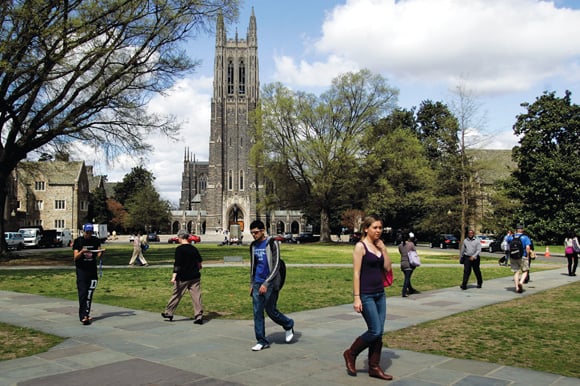Skyrocketing costs of private schools has advisers telling clients to consider less-prestigious -- and less expensive -- colleges for their kids
When it comes to higher education these days, it is all about bang for the buck.
With tuition and fees at U.S. public universities up 8.3% last year — at private colleges they were up 4.3% — President Barack Obama said in his State of the Union address that he wants states and colleges to do a better job of controlling costs.
The average bill for an in-state student at a public four-year school is $17,131 a year and $38,589 at a four-year private college.
Financial advisers also are taking a whack at soaring college costs by recommending that their clients first consider less expensive public colleges, or at least carefully weigh the costs of sending their children to an expensive private college against the practical benefits that such an education will produce in the labor market.
“When someone doesn't even know what they want to do, $50,000 a year is a very expensive experiment to find out,” said Harvey Meldrum, founder of Meldrum Financial LLC.
Under Mr. Obama's plan, states with policies that keep college costs down, perhaps by better use of technology, adjusting graduation requirements to help students finish within four years, or accepting more credits that students have earned at other schools, will compete for an extra $1 billion, according to Martha Kantor, undersecretary of the Education Department.
The president also would make several billion dollars more in federal student aid available to colleges and universities that control tuition costs while maintaining quality education.
“We can't restrict tuition,” but the administration can provide innovative funding to stabilize prices, Ms. Kantor told a congressional panel held to discuss college affordability.
Another proposal out of the White House would create a score card to examine the value each of the nation's nearly 6,000 colleges and universities offer.
It would allow families to compare cost, quality of education, financial aid available, average number of years to graduate, available scholarships and other information to help families evaluate the schools' worthiness, Ms. Kantor said.
Even as details of the president's efforts to rein in college inflation are unveiled today in the administration's 2013 budget, some Republicans are already criticizing his efforts as being motivated to secure votes from young adults in this year's election.
Many advisers see college inflation as a threat to clients' security at a time when such costs are outpacing overall inflation and even the rate at which health care costs are going up.
Greg Olsen, a partner at Lenox Advisors Inc., sometimes shocks wealthy parents when he recommends sending their undergraduates to state colleges that often cost $30,000 to $40,000 a year less than some private universities.
“It might be the difference of a pretty campus or college athletics, but there's no proof to show [that] you will be more successful if you go to a private college rather a public one,” he said.
For graduate school, Mr. Olsen said, it is worth it for a student to attend the most prestigious school to which they have been accepted.
In a few circumstances, expensive undergraduate programs can be worth it, too, he said.
But unless a private school offers an alumni network from which students will benefit, such as the New York clubs of Harvard, Yale or Cornell universities, a state school can provide the same education and likely save parents about $90,000 a child, Mr. Olsen said.
If a student has to take out loans to pay off the difference in cost between a public and private university, they could be graduating after four years with a $1,000-a-month student loan bill, Mr. Olsen said.
“That's as much as a small mortgage, but it doesn't give the new graduate anywhere to live but in mom's and dad's place,” he said. “It's difficult out there financially right now, and these kids have to graduate lean and mean.”
In fact, nationally, there's been a jump in the number of private and public college students who can't repay their student loans, according to a survey of bankruptcy attorneys that was released last week. There's about $1 trillion in student loans outstanding in the U.S., which is more than the nation's credit card debt.
“This could very well be the next debt bomb for the U.S. economy,” said William Brewer, president of the National Association of Consumer Bankruptcy Attorneys, which conducted the survey.
“Students and workers seeking retraining are borrowing extraordinary amounts of money through federal and private loan programs to help cover the rising cost of college and training,” he said.
Those who graduated in 2010 with student loans owe an average $25,250, a 5% rise from 2009 graduates. Parents of 2010 graduates owe an average $34,000, the association said, based on figures from The Institute for College Access and Success.
Mr. Meldrum, who has a college admission counselor on the staff of his advisory firm, said that clients are much more concerned with the cost of college than they were five years ago. Like Mr. Olsen, he often recommends choosing a $25,000-a-year college over one for $50,000.
“There's a perception that there's value in paying $45,000 or more a year for school,” Mr. Meldrum said.
That isn't true unless, perhaps, it is going for an undergraduate degree from an Ivy League school or what he calls the sub-Ivys.
But those schools have become so competitive that only the top 1% of students from even an affluent area are accepted, Mr. Meldrum said.
A few schools that are very competitive and a great value are the University of Virginia, University of North Carolina Chapel Hill, James Madison Universit and the College of William and Mary, he said.
The College of New Jersey also is an excellent value, Mr. Meldrum said.
His advice for parents: “Don't get sucked into buying a really expensive decal for your car.”







